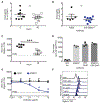Frontline Science: Superior mouse eosinophil depletion in vivo targeting transgenic Siglec-8 instead of endogenous Siglec-F: Mechanisms and pitfalls
- PMID: 32134149
- PMCID: PMC7585130
- DOI: 10.1002/JLB.3HI0120-381R
Frontline Science: Superior mouse eosinophil depletion in vivo targeting transgenic Siglec-8 instead of endogenous Siglec-F: Mechanisms and pitfalls
Abstract
Eosinophils are important multifunctional granulocytes. When studying eosinophil function and its contribution to diseases, mouse models are often used. Mouse eosinophils selectively express sialic acid-binding immunoglobulin-like lectin (Siglec)-F. Its closest functional paralog on human eosinophils is Siglec-8. These Siglecs are being used to target eosinophils when exploring their mechanistic roles in disease and for potential therapeutic benefit. In order to facilitate preclinical studies of human Siglec-8, we developed transgenic mouse strains expressing human Siglec-8 only on the surface of eosinophils with or without endogenous Siglec-F and have begun characterizing various cellular functions in vitro and in vivo. Eosinophils from Siglec-8+ mice, with or without Siglec-F, responded to Siglec-8 antibody engagement in vitro by up-regulating surface CD11b, whereas Siglec-F antibody had no such effect. Engagement of Siglec-F or Siglec-8 with respective antibodies in vitro resulted in only modest increases in cell death. Administration of rat Siglec-F antibodies to mice led to a significant decrease in Siglec-F surface expression on eosinophils due to internalization, and thus appeared to decrease eosinophil numbers based on Siglec-F+ cells, but with proper gaiting strategies did not in fact result in significant eosinophil depletion. In marked contrast, administration of mouse Siglec-8 antibodies rapidly and effectively depleted eosinophils from blood and spleens of mice, but an F(ab')2 version did not, indicating an Fc-mediated mechanism for eosinophil depletion in vivo. Siglec-8 expressing mice with or without endogenous Siglec-F will be useful to study Siglec-8-based therapeutics, and may be a preferred approach when acute or chronic eosinophil depletion is needed.
Keywords: Siglec-8; Siglec-F; antibody-dependent cellular cytotoxicity; depletion; eosinophils.
©2020 Society for Leukocyte Biology.
Conflict of interest statement
Disclosure
B.S.B. receives remuneration for serving on the scientific advisory board of Allakos, Inc. and owns stock in Allakos. He receives publication-related royalty payments from Elsevier and UpToDate®. He is a co-inventor on existing Siglec-8–related patents and thus may be entitled to a share of royalties received by Johns Hopkins University during development and potential sales of such products. Dr. Bochner is also a co-founder of Allakos, which makes him subject to certain restrictions under University policy. The terms of this arrangement are being managed by Johns Hopkins University and Northwestern University in accordance with their conflict of interest policies. The other authors have no competing financial interests.
Figures








Comment in
-
Divergent Siglec-F(eights) of mouse and human eosinophil death.J Leukoc Biol. 2020 Jul;108(1):9-11. doi: 10.1002/JLB.5CE0520-108R. Epub 2020 Jun 18. J Leukoc Biol. 2020. PMID: 32557797 Free PMC article.
References
Publication types
MeSH terms
Substances
Grants and funding
LinkOut - more resources
Full Text Sources
Other Literature Sources
Molecular Biology Databases
Research Materials

